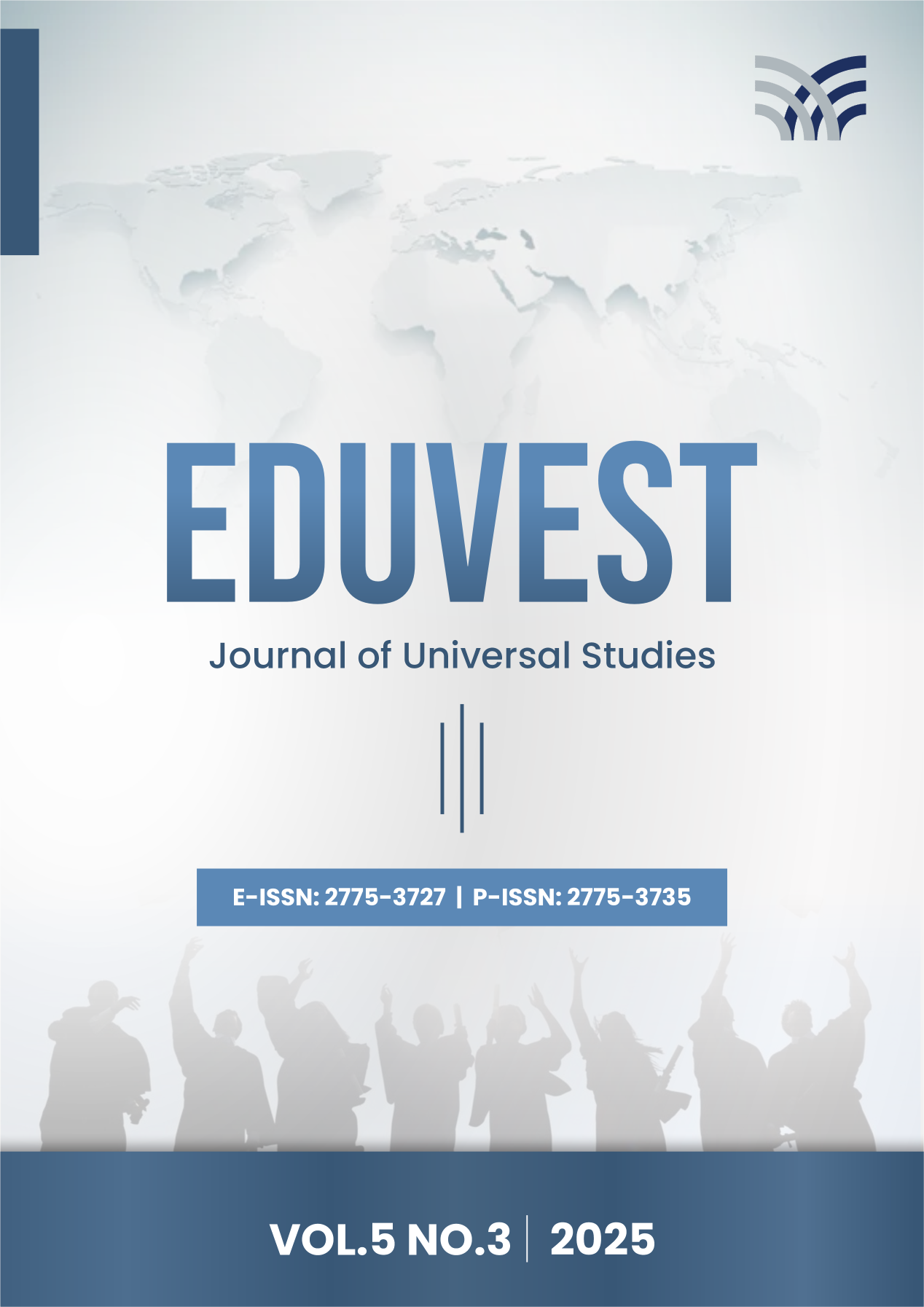Pre-Targeting Bispecific Antibody (BSAB) and Pegylated Liposomal Drug Nanocarrier as Management of Acute Lymphoblastic Leukemia (ALL) In Pediatrics
##semicolon##
https://doi.org/10.59188/eduvest.v5i3.1768##semicolon##
bispecific antibody##common.commaListSeparator## PEGylated liposom##common.commaListSeparator## immunotherapy##common.commaListSeparator## leukemia##common.commaListSeparator## pediatricAbstrakt
Acute lymphoblastic leukemia (ALL) is a neoplastic condition commonly found in pediatric patients especially that involve B cell (B-ALL). Current treatments revolve around immunotherapy approaches such as Chimeric-Antigen Receptor T-cell (CAR-T) and tyrosine kinase inhibitor (TKI). However, flaws in both methods such as low pharmacokinetics, technical limitations, inability to recognize more than one antigen and other side effects remain a predicament to be solved. “immunotherapy”, “pediatry”, “b-all”, “bispesific antibody” and “PEGylated liposomal” were the keywords applied to scientific online databases, such as ScienceDirect, PubMed, dan Researchgate. A total of 25 journals were screened, reviewed and utilized with utmost precision to construct a literature review. Preparation of targeting bispesific antibody (BsAb) is constructed through the formation of chemical bond between the anti-mPEG scFV and CD20, whereas PEGylated liposomal drug nanocarriers is prepared through a covalent bonding chemical reaction. PEGylated drug nanocarriers has nontoxic, immunogenicity, antigenicity, and long half-life properties that increases both the pharmacokinetics and pharmacodynamics of anticancer drugs like chemotherapy through increased distribution, accumulation and decrease elimination of the drugs. BsAb will specifically target cancer-specific antigens, such as CD20 in cancer cells to initiate adaptive immune responses. Additionally, the antibody dependent endocytosis properties are a vital part in cancer therapy to increase cellular uptake of the liposome. All in all, the combination of bispesific antibody (BsAb) PEGylated liposomal drug nanocarriers towards B-ALL shows great promise towards the management of B-ALL in pediatric patients.
##submission.citations##
Aldoss, I., & Stein, A. S. (2018). Advances in adult acute lymphoblastic leukemia therapy. Leukemia & Lymphoma, 59(5), 1033–1050.
Alhallak, K., Sun, J., Wasden, K., Guenthner, N., O’Neal, J., Muz, B., King, J., Kohnen, D., Vij, R., & Achilefu, S. (2021). Nanoparticle T-cell engagers as a modular platform for cancer immunotherapy. Leukemia, 35(8), 2346–2357.
Alshibani, E., AlShaibani, Z., & Al-Anazi, K. A. (2018). Hematopoietic Stem Cell Transplantation for Acute Lymphoblastic Leukemia in the Era of Novel Therapies. Stem Cells in Clinical Practice and Tissue Engineering, 159.
Brinkmann, U., & Kontermann, R. E. (2017). The making of bispecific antibodies. MAbs, 9(2), 182–212. https://doi.org/10.1080/19420862.2016.1268307
Coccaro, N., Anelli, L., Zagaria, A., Specchia, G., & Albano, F. (2019). Next-generation sequencing in acute lymphoblastic leukemia. International Journal of Molecular Sciences, 20(12), 2929.
Cornelison, M., Jabbour, E. J., & Welch, M. A. (2012). Managing side effects of tyrosine kinase inhibitor therapy to optimize adherence in patients with chronic myeloid leukemia: the role of the midlevel practitioner. Journal of Supportive Oncology, 10(1), 14–23.
Foà, R., Bassan, R., Vitale, A., Elia, L., Piciocchi, A., Puzzolo, M.-C., Canichella, M., Viero, P., Ferrara, F., & Lunghi, M. (2020). Dasatinib–blinatumomab for Ph-positive acute lymphoblastic leukemia in adults. New England Journal of Medicine, 383(17), 1613–1623.
Hunger, S. P., & Mullighan, C. G. (2015). Acute lymphoblastic leukemia in children. New England Journal of Medicine, 373(16), 1541–1552.
King, A. C., Pappacena, J. J., Tallman, M. S., Park, J. H., & Geyer, M. B. (2019). Blinatumomab administered concurrently with oral tyrosine kinase inhibitor therapy is a well-tolerated consolidation strategy and eradicates measurable residual disease in adults with Philadelphia chromosome positive acute lymphoblastic leukemia. Leukemia Research, 79, 27–33.
Li, L., & Wang, Y. (2020). Recent updates for antibody therapy for acute lymphoblastic leukemia. Experimental Hematology and Oncology, 9(1), 1–11. https://doi.org/10.1186/s40164-020-00189-9
Li, X., & Chen, W. (2019). Mechanisms of failure of chimeric antigen receptor T-cell therapy. Current Opinion in Hematology, 26(6), 427–433.
Liu, Y.-F., Wang, B.-Y., Zhang, W.-N., Huang, J.-Y., Li, B.-S., Zhang, M., Jiang, L., Li, J.-F., Wang, M.-J., & Dai, Y.-J. (2016). Genomic profiling of adult and pediatric B-cell acute lymphoblastic leukemia. EBioMedicine, 8, 173–183.
Maude, S. L., Laetsch, T. W., Buechner, J., Rives, S., Boyer, M., Bittencourt, H., Bader, P., Verneris, M. R., Stefanski, H. E., & Myers, G. D. (2018). Tisagenlecleucel in children and young adults with B-cell lymphoblastic leukemia. New England Journal of Medicine, 378(5), 439–448.
Paul, S., Kantarjian, H., & Jabbour, E. J. (2016). Adult acute lymphoblastic leukemia. Mayo Clinic Proceedings, 91(11), 1645–1666.
Pehlivan, K. C., Duncan, B. B., & Lee, D. W. (2018). CAR-T cell therapy for acute lymphoblastic leukemia: transforming the treatment of relapsed and refractory disease. Current Hematologic Malignancy Reports, 13, 396–406.
Perdana, A. B., Saputra, F., & Aisyi, M. (2020). Update on diagnosis of childhood acute lymphoblastic leukemia (ALL) in Indonesia. Indonesian Journal of Cancer, 14(4), 115–116.
Terwilliger, T., & Abdul-Hay, M. (2017). Acute lymphoblastic leukemia: a comprehensive review and 2017 update. Blood Cancer Journal, 7(6), e577–e577.
Wang, Q., Chen, Y., Park, J., Liu, X., Hu, Y., Wang, T., McFarland, K., & Betenbaugh, M. J. (2019). Design and Production of Bispecific Antibodies. Antibodies, 8(3), 43. https://doi.org/10.3390/antib8030043
Wang, Z., Wu, Z., Liu, Y., & Han, W. (2017). New development in CAR-T cell therapy. Journal of Hematology & Oncology, 10, 1–11.
Xu, X., Sun, Q., Liang, X., Chen, Z., Zhang, X., Zhou, X., Li, M., Tu, H., Liu, Y. U., & Tu, S. (2019). Mechanisms of relapse after CD19 CAR T-cell therapy for acute lymphoblastic leukemia and its prevention and treatment strategies. Frontiers in Immunology, 10, 2664.
##submission.downloads##
Publikované
##submission.howToCite##
Číslo
Sekcia
##submission.license##
##submission.copyrightStatement##
##submission.license.cc.by-sa4.footer##










